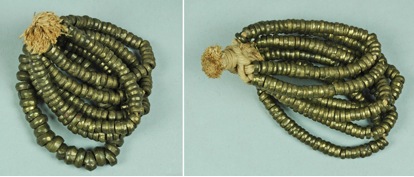Anklets
Mangbetu people, Democratic Republic of Congo
 Collected by S.P. Powell and donated by him in 1940; 1940.7.027These ankle ornaments are made from lots of small brass rings strung on strands of bast and knotted together at one end. Known locally as ekoki, they were made by the Mangbetu people and worn by a chief's favourite girls and wives.
Collected by S.P. Powell and donated by him in 1940; 1940.7.027These ankle ornaments are made from lots of small brass rings strung on strands of bast and knotted together at one end. Known locally as ekoki, they were made by the Mangbetu people and worn by a chief's favourite girls and wives.
This ornament refers to a status gained not by achievement but by association. The chief would display his position through ornate feather ornaments and finely made knives and shields, and his status was transferred to his wives, who showed their elevated rank by wearing these ornaments.
The Mangbetu have a distinctive artistic culture – their round houses are often decorated with varied designs, they sculpt stools and pots in unexpected shapes and, although less common today, women would have their skulls artificially shaped from infancy into an elongated shape, topped off with the typical complicated halolike hairstyle decorated with metal and ivory hairpins.
In other societies the status of a man could equally be transferred to his wife or other female relatives, who were then entitled to wear special ornaments. In northeast India, the daughter of a Konyak Naga chief could wear a hornbill feather headdress, whilst the wife or daughter of an Ao Naga man who had sacrificed a mithan was entitled to wear a drongo feather in her ear. In the United States, the president's wife does not wear particular ornaments, but she is given a special title: she is always known as the First Lady. Similarly among European monarchies the wife or husband of the monarch is known as the Queen or Prince Consort. As with these ornaments, these titles are a reflection of the spouse's status and not a status achieved alone.
